Family
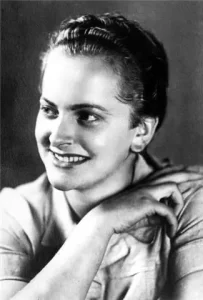
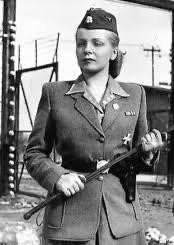 Raised by farming parents, who hated Nazis and all that they stood for, didn’t stop Irma Grese from wanting to join the Bund Deutscher Mädel or League of German Girls. Nevertheless, her father forbade it. Irma Elisabeth Ilse Ida Grese was born to Berta Grese and Alfred Grese, both dairy workers, on October 7, 1923. She was the third of five children (three girls and two boys). While Irma was an “angelic” looking girl with blond hair and blue eyes, there was something else living behind those eyes, a determination to get what she wanted…no matter the cost. In 1938 at the age of 15, Irma left school and worked as an assistant nurse in the sanatorium of the SS.
Raised by farming parents, who hated Nazis and all that they stood for, didn’t stop Irma Grese from wanting to join the Bund Deutscher Mädel or League of German Girls. Nevertheless, her father forbade it. Irma Elisabeth Ilse Ida Grese was born to Berta Grese and Alfred Grese, both dairy workers, on October 7, 1923. She was the third of five children (three girls and two boys). While Irma was an “angelic” looking girl with blond hair and blue eyes, there was something else living behind those eyes, a determination to get what she wanted…no matter the cost. In 1938 at the age of 15, Irma left school and worked as an assistant nurse in the sanatorium of the SS.
As I looked at Irma’s life, I wondered how she could have possibly gone in such a horrific direction with the parents she had. Then, I realized that in Germany in the 1930s, parents were quickly losing the right to raise their own children. They had no control over the education process, and in fact, the Nazi regime was quickly making the children believe that their parents were uneducated and stupid. The Nazi regime backed the “right” of the children to choose their destiny…provided it was “in sync” with the Nazi agenda. In 1936, her mother died by suicide after drinking hydrochloric acid following the discovery of Alfred’s affair with the local pub owner’s daughter. This might have contributed to Irma’s coming disobedience.
Despite Alfred, her farmer father’s objections, Irma was determined to join the Nazi party, because of the opportunity to become a nurse that they were offering her. She began studying at Hohenlychen, a SS hospital as an assistant nurse, in 1939. During her time there, she worked with Dr Karl Gebhardt, who performed medical experiments on patients, but he was unsuccessful at nursing and moved on to be a machinist. Once she was 18, she joined the Aufseherinnen SS and, after passing the necessary examinations, entered training at Ravensbrück. At Ravensbrück, Irma trained for three weeks (the program was a month, but Irma was an eager learner, and so went through it in three weeks). It is believed that she also had numerous relationships with male officers, which may have helped to “cut down” on her education time.
In 1943, Irma was sent to Auschwitz-Birkenau to guard female prisoners and was promoted the following year to the second-highest position within the Aufseherinnen at the camp. Due to her transfer, Irma had a falling out with her father, as he had been vehemently opposed to her joining the SS entourage, and he expelled her from the house. She oversaw 30,000 female prisoners at Auschwitz-Birkenau, and she was known to be brutal. The inmates at Auschwitz nicknamed her The Hyena of Auschwitz…probably because of the fact that she delighted in their pain. She wore heavy boots, carried a whip, and a pistol. While her appearance was that of a kindly person, she was known to have an affinity for kicking and beating prisoners, walking around camp with two hungry dogs trained to kill, and generally inflicting pain upon anyone who committed the slightest offense. She took pleasure in having the camp doctor operate on prisoners without anesthetic and, according to Dr Gisella Perl (the woman who performed an abortion for Irma on one occasion), she enjoyed the “sight of this human suffering. Her tense body swung back and forth in a revealing, rhythmical motion. Her cheeks were flushed and her wide-open eyes had the rigid, staring look of complete sexual paroxysm.”
Irma was transferred to Ravensbrück in January 1945, before being sent to Bergen-Belsen in March…where 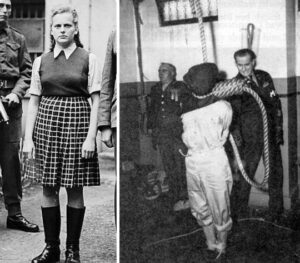
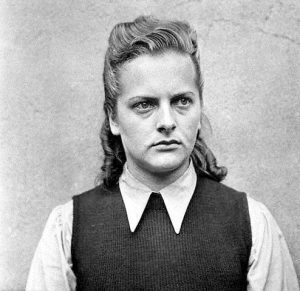 her brutal behavior continued. She enjoyed torturing the women under her control. She made women kneel for long periods of time, or hold large rocks over their heads, or stand in the snow or rain for hours. She felt no pity. Irma was captured by British soldiers in April 1945 and put on trial soon after. She claimed that she was just following orders and serving the state. She showed no remorse…even as she was sentenced to hang. Irma was hanged on December 13, 1945. At the age of 22, she was the youngest Nazi criminal to be executed.
her brutal behavior continued. She enjoyed torturing the women under her control. She made women kneel for long periods of time, or hold large rocks over their heads, or stand in the snow or rain for hours. She felt no pity. Irma was captured by British soldiers in April 1945 and put on trial soon after. She claimed that she was just following orders and serving the state. She showed no remorse…even as she was sentenced to hang. Irma was hanged on December 13, 1945. At the age of 22, she was the youngest Nazi criminal to be executed.

 My niece, Kayla Stevens is a great mom to the daughter that she and my nephew, Garrett Stevens share. Elliott will be 4 years old on August 3rd, and she will become a big sister just a few days from now. The really nice thing for Kayla with this new baby is that she works from home. While Elliott goes to daycare, because Kayla’s job is such that having an older child at home during working hours is not feasible, having the baby at home will be ok, probably for the first year or so anyway. That will be a wonderful bonding time for the two of them too. By then, Elliott will be in school, so Kayla and Garrett will still only have to have one child in daycare, which is nice, considering the cost of daycare. We are all excited for their coming little addition, and they are busily getting ready.
My niece, Kayla Stevens is a great mom to the daughter that she and my nephew, Garrett Stevens share. Elliott will be 4 years old on August 3rd, and she will become a big sister just a few days from now. The really nice thing for Kayla with this new baby is that she works from home. While Elliott goes to daycare, because Kayla’s job is such that having an older child at home during working hours is not feasible, having the baby at home will be ok, probably for the first year or so anyway. That will be a wonderful bonding time for the two of them too. By then, Elliott will be in school, so Kayla and Garrett will still only have to have one child in daycare, which is nice, considering the cost of daycare. We are all excited for their coming little addition, and they are busily getting ready.
Kayla is social worker with the Veterans Administration in Sheridan. I can’t think of a more caring person for our veterans. She has found that her work with the Veterans Administration has truly been fulfilling. When she first started working as a social worker, she was on the substance abuse team at the Wyoming Mental Health Team, which I think was probably the hardest of her positions. Later she was moved to the child and family team, which I really thought she would stay with. I think the Lord just had better plans for her, and her work with the Veteran’s Administration has shown that to be true. Our veterans deserve caring people, like Kayla, to help with their needs,
Kayla’s may life work, however, will always be her family. She loves spending time with her daughter and husband. They go to the park, and Elliott delights them with her antics. She is a smart little girl and is always showing them what she can do. They have her in swimming and gymnastics, and she is always wowing them with her tricks. Being a mom is probably the greatest blessing Kayla has ever received, and becoming a mom 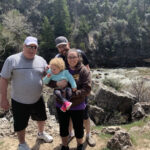
 again is just as awesome. I can’t believe how close the date is getting, and I can’t wait to meet baby Stevens number two. I love that Kayla is so good about sending me videos and pictures of Elliott’s life and activities. It is hard when these kids live in a different town, but she makes it easy to be a part of their lives…and I very much appreciate that. Today is Kayla’s birthday. Happy birthday Kayla!! Have a great day!! We love you!!
again is just as awesome. I can’t believe how close the date is getting, and I can’t wait to meet baby Stevens number two. I love that Kayla is so good about sending me videos and pictures of Elliott’s life and activities. It is hard when these kids live in a different town, but she makes it easy to be a part of their lives…and I very much appreciate that. Today is Kayla’s birthday. Happy birthday Kayla!! Have a great day!! We love you!!

 In the years before GPS (Global Positioning System), lighthouses were a vital part of keeping ships off of the shore, rocks just below the surface, and islands. While necessary, lighthouses were not always easy to build. Of course, a lighthouse that sat on the shoreline of a coast was a fairly simple build, but one that sat on the top of a dangerous rock outcropping was more difficult, especially if the rocks were very tall and hard to access, like the Pridrangaviti Lighthouse in the Westman Islands of Iceland.
In the years before GPS (Global Positioning System), lighthouses were a vital part of keeping ships off of the shore, rocks just below the surface, and islands. While necessary, lighthouses were not always easy to build. Of course, a lighthouse that sat on the shoreline of a coast was a fairly simple build, but one that sat on the top of a dangerous rock outcropping was more difficult, especially if the rocks were very tall and hard to access, like the Pridrangaviti Lighthouse in the Westman Islands of Iceland.
The Pridrangaviti Lighthouse was built in 1938, right before the onset of World War II. Its construction was by 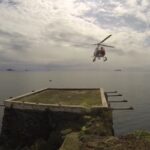 no means an easy task. Construction workers had to scale the cliff to reach the place where they were to lay the lighthouse groundwork. This mean facing slick rocks, rain, winds, and even heavy surf. One misstep would lead to their death on the rocks and icy North Atlantic Ocean below. Nevertheless, the task was eventually finished, and the effect is quite beautiful.
no means an easy task. Construction workers had to scale the cliff to reach the place where they were to lay the lighthouse groundwork. This mean facing slick rocks, rain, winds, and even heavy surf. One misstep would lead to their death on the rocks and icy North Atlantic Ocean below. Nevertheless, the task was eventually finished, and the effect is quite beautiful.
The lighthouse warns passing ships of a cluster of slender rock pillars that jut out from the ocean’s surface. The pillars look like fingers stretching toward the sky, and they are located miles away from civilization. The lighthouse looks like a colorful speck on top of the largest pillar. The tiny, red-roofed lighthouse is quite likely one of the loneliest lighthouses in the world, and I don’t think I would want to be the person who had the job of manning it. The lighthouse is the only thing on the rock, and so you would likely be there for at least a month at a time before it would be feasible to leave.
Repairs were a big issue as well…at least until modern times. These days, when repairs are needed, supplies 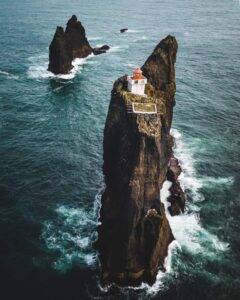
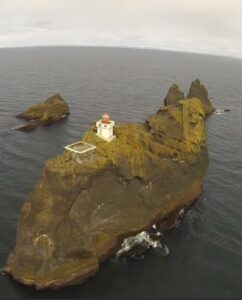 and workers can be helicoptered in. And these days, the rock sports a helicopter pad for any visitors who might go there. You could also get there by boat and go rock climbing to reach the top, but anyone who goes must know that visiting the Pridrangaviti lighthouse is a dangerous endeavor. One wrong step, and any unsuspecting explorers just may find themselves going for an unplanned swim with the killer whales that like to hang out in the waves below. Nevertheless, just imagine being able to go and visit such a lighthouse. I’m not a rock climber, so I don’t know about climbing up, but to helicopter in and be able to explore the lighthouse and the grounds…yep, that would be very cool.
and workers can be helicoptered in. And these days, the rock sports a helicopter pad for any visitors who might go there. You could also get there by boat and go rock climbing to reach the top, but anyone who goes must know that visiting the Pridrangaviti lighthouse is a dangerous endeavor. One wrong step, and any unsuspecting explorers just may find themselves going for an unplanned swim with the killer whales that like to hang out in the waves below. Nevertheless, just imagine being able to go and visit such a lighthouse. I’m not a rock climber, so I don’t know about climbing up, but to helicopter in and be able to explore the lighthouse and the grounds…yep, that would be very cool.
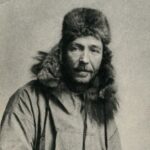
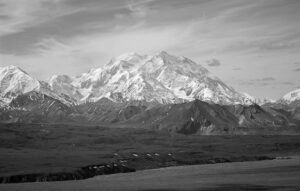 As a hiker, I can relate to the draw of a mountain peak, but I was never one to do the winter-ice-climbing-up-a-solid-rock-face type of hiker. I like trail hiking personally, but there are many people who would disagree with me on that. One such hiker/climber was Hudson Stuck, an Alaskan missionary, who on June 7, 1913, led the first successful ascent of Denali…also known as Mount McKinley, before they changed the name. Denali, at 20,320 feet is the highest on the American continent. In fact, there are planes that don’t fly that high…small planes, but nevertheless, they don’t go that high, and would have to fly around Denali.
As a hiker, I can relate to the draw of a mountain peak, but I was never one to do the winter-ice-climbing-up-a-solid-rock-face type of hiker. I like trail hiking personally, but there are many people who would disagree with me on that. One such hiker/climber was Hudson Stuck, an Alaskan missionary, who on June 7, 1913, led the first successful ascent of Denali…also known as Mount McKinley, before they changed the name. Denali, at 20,320 feet is the highest on the American continent. In fact, there are planes that don’t fly that high…small planes, but nevertheless, they don’t go that high, and would have to fly around Denali.
Not crazy enough to try Denali solo, Stuck recruited Harry Karstens, a respected guide, to join his expedition as co-leader. Other members were Walter Harper and Robert G Tatum, both 21, and two student volunteers from the mission school, John Fredson and Esaias George. They departed from Nenana on March 17, 1913. They reached the summit of Denali on June 7, 1913…nearly three months later. Harper, who was of mixed Alaska Native and Scots descent, reached the summit first. Fredson, who was just 14, acted as their base camp manager, hunting caribou and Dall sheep to keep them supplied with food.
There is snow on the mountain year-round, and the air up there is thin, requiring some climbers to bring oxygen. Experienced climbers might be able to climb Denali without oxygen, but sometimes, no matter how fit the body, it can fall victim to the effects of low oxygen…fatigue, hyperventilation, fainting, or worse. So, whether it is needed or not, oxygen is a good idea to have on the trek.
Stuck, who was born in London on November 4, 1863, is an accomplished amateur mountaineer. Mountain climbing, like hiking is an addictive passion, once it takes hold of a person. The feeling you get when you are out there, pushing yourself to new heights or longer hikes, simply can’t be matched in any gym. After moving to the United States, in 1905 Stuck became archdeacon of the Episcopal Church in Yukon, Alaska. His treks across Alaska’s difficult terrain were to preach to villagers and establish schools. His climbing of Denali was more a personal goal than a church oriented one. Stuck was an adventure-seeker, and it was that spirit that drove him to higher heights in every area of his life. And it was that spirit that drove him to the mountain tops…maybe to worship God there too. He was a missionary, after all.
Mount McKinley National Park was established as a wildlife refuge in 1917. Harry Karstens served as the park’s first superintendent. In 1980, the park was expanded and renamed Denali National Park and Preserve. 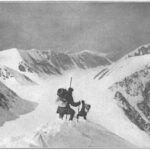
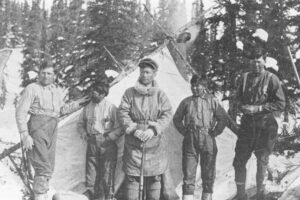 Encompassing 6 million acres, the park is larger than Massachusetts. In 2015, the mountain was officially renamed Denali. Hudson Stuck died of bronchial pneumonia at Fort Yukon, in his beloved Alaska on October 10, 1920. He was 56 years old. At his request, Stuck, still a British citizen is buried in the local cemetery at Fort Yukon. Today, over 1,000 hopeful climbers attempt to scale Denali each year, with about half of them successfully reaching their goal.
Encompassing 6 million acres, the park is larger than Massachusetts. In 2015, the mountain was officially renamed Denali. Hudson Stuck died of bronchial pneumonia at Fort Yukon, in his beloved Alaska on October 10, 1920. He was 56 years old. At his request, Stuck, still a British citizen is buried in the local cemetery at Fort Yukon. Today, over 1,000 hopeful climbers attempt to scale Denali each year, with about half of them successfully reaching their goal.
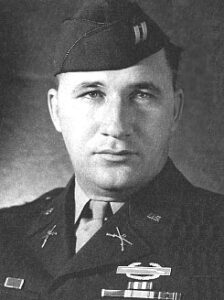 Captain Leonard Treherne “Max” Schroeder Jr looked out over the choppy water between the landing craft he was on and the shores of their destination…the beaches of Normandy, France. The beaches had been given code names, to protect the mission…Utah, Omaha, Gold, Juno, and Sword; the operation was code named Overlord. The beach ahead of Schroeder had been code named Utah. Along the hills behind the beach were many German bunkers, with armed German snipers hiding inside of them. Schroeder knew they were just waiting for them to step onto the beach before the snipers would open fire.
Captain Leonard Treherne “Max” Schroeder Jr looked out over the choppy water between the landing craft he was on and the shores of their destination…the beaches of Normandy, France. The beaches had been given code names, to protect the mission…Utah, Omaha, Gold, Juno, and Sword; the operation was code named Overlord. The beach ahead of Schroeder had been code named Utah. Along the hills behind the beach were many German bunkers, with armed German snipers hiding inside of them. Schroeder knew they were just waiting for them to step onto the beach before the snipers would open fire.
Schroeder was about to find out firsthand, just how bad this day was going to be. In fact, he was the first American soldier whose feet hit the sand on the beach at Normandy on D-Day…so, while his men were right behind him, he would experience this horrific battle at its inception. I have wondered just how they knew that he was first amid all that chaos, but it is a documented fact. Operation Overlord was pivotal in the United States’ overall success, but it was also extremely bloody, with great loss of life. While every life lost was horrific, the men who stormed the beaches of Normandy that day were willing to give their lives for a 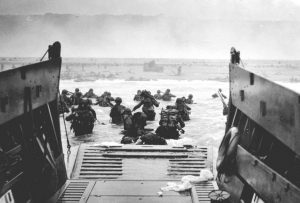 cause that they felt was essential…and I have so much respect for each and every one of them. Captain Schroeder led his team of men onto the beach…along with thousands of others…and managed to get them to their secured location. Nevertheless, during the mission, he was shot twice by German snipers. Once the mission was accomplished and his men were where they needed to be, Captain Schroeder passed out from his injuries.
cause that they felt was essential…and I have so much respect for each and every one of them. Captain Schroeder led his team of men onto the beach…along with thousands of others…and managed to get them to their secured location. Nevertheless, during the mission, he was shot twice by German snipers. Once the mission was accomplished and his men were where they needed to be, Captain Schroeder passed out from his injuries.
Schroeder woke up at an aid station on the beach, with medics taking care of his wounds so he could be transported to an army hospital in England. While in England, he recovered and had a lot of time to read all about his role in the successful mission…in many papers. I don’t know if he realized that his had been such a pivotal role in the battle, but it had. At the time, I doubt if he thought he would ever see that beach again, but in 1994, Schroeder revisited the beach at Normandy as a guest of the French 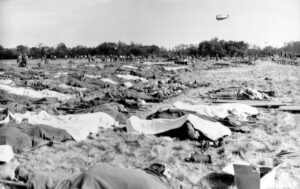 government. It was an amazing ceremony to pay homage to his heroic efforts that helped turn the tide for the Allies in World War II. It was an honor he had given no thought to as he looked out at that beach on that long ago June 6, 1944…but, an honor that he had earned along with all the other men who fought, and the many who had died. I’m sure those who gave all, were thankful that some made it home and managed to live a long life of liberty. Captain Leonard “Max” Schroeder, who was born on July 16, 1918, in Linthicum Heights, Maryland, passed away from emphysema early on the morning of May 26, 2009, in Largo, Florida at the age of 90.
government. It was an amazing ceremony to pay homage to his heroic efforts that helped turn the tide for the Allies in World War II. It was an honor he had given no thought to as he looked out at that beach on that long ago June 6, 1944…but, an honor that he had earned along with all the other men who fought, and the many who had died. I’m sure those who gave all, were thankful that some made it home and managed to live a long life of liberty. Captain Leonard “Max” Schroeder, who was born on July 16, 1918, in Linthicum Heights, Maryland, passed away from emphysema early on the morning of May 26, 2009, in Largo, Florida at the age of 90.
 Some heroes are forever unknown, and the hero of Tiananmen Square remains unknown to this day. I’m not sure how they can manage never to tell anyone about their heroic act, but then in 1989 Bejing, China, being able to keep your mouth shut was tantamount to staying alive.
Some heroes are forever unknown, and the hero of Tiananmen Square remains unknown to this day. I’m not sure how they can manage never to tell anyone about their heroic act, but then in 1989 Bejing, China, being able to keep your mouth shut was tantamount to staying alive.
The summer of 1989 found Tiananmen Square in Bejing overtaken with pro-democracy protestors…a situation that the communist government was not happy about. Students, workers, soldiers, and teachers had joined together in peaceful protest, seeking democracy, freedom of the press, and freedom of speech. As the protests progressed, they were joined by more, and more…and still more people. At the height of the protest, an estimated one million people were milling around in the square, and their efforts were becoming known worldwide. In fact, the world was becoming inspired by the efforts of the protestors.
The Chinese government, however, was becoming highly agitated by what was going on, because they felt like they were losing control. So, on June 4, the Chinese government cracked down on those protests in the most horrific way. They sent in armed military and tanks. The inevitable result was that the government killed hundreds, and even thousands of protestors, even shooting them in the back as they were running away.

The killing continued into the next day, and just after noon on June 5 a line of eighteen tanks began rolling down Avenue of Eternal Peace. The tanks, representative of a corrupt government power, came lumbering down the street…impenetrable, unstoppable, and fully able to squash a person like a bug. The show of force continued its parade down the Avenue, toward Tiananmen Square…until one lone man stood in their way. The unknown man, dressed in a simple white shirt and black pants, holding two shopping bags, strode into the Avenue and stood directly in front of the lead tank. Amazingly, it stopped. Then the tank moved right, but the unknown man countered. Then it moved left, and he countered again. The standoff drew national attention, and the unknown man became known as “Tank Man.” The interaction lasted just a few minutes, it proved that one “everyday person” can accomplish a lot, by standing up to tyranny. One report suggested that he was the son of factory workers…a blue-collar guy growing up in a blue-collar family in a blue-collar neighborhood. And because of censorship restrictions in China, he may not even know about the images of him, or that Time Magazine named him one of the century’s “top revolutionaries.” The reality is that he wasn’t a revolutionary…at least not in the sense that he went out and fought with the resistance. He was just a guy who saw something that was horribly wrong and decided that it was enough!! His stand said simply, “No More!!”
This everyday citizen managed, single-handedly to stop the killing that day, and he intended to do it even if it  cost him his life. That is inspiring, because it tells us that if we see something wrong and decide to take action, we too can change the world. If we sit idly by and do nothing to stop tyranny, then we are no better than those who are bringing tyranny.
cost him his life. That is inspiring, because it tells us that if we see something wrong and decide to take action, we too can change the world. If we sit idly by and do nothing to stop tyranny, then we are no better than those who are bringing tyranny.
We are seeing movements just like this one man since the 2020 election. People who have never run for office before, suddenly are. People are showing up at school board meetings, city council meeting, and other such governmental meetings. People are taking a stand and proving that we are a voice to be reconned with, and we will not be bullied anymore.

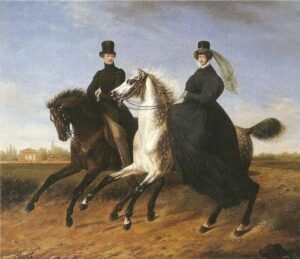 Most of us have seen strange events, designed to be something no one else has done. Things like getting married in a hot air balloon, or during a skydive, or even on horseback. And speaking of horseback…how about dining on horseback. I know, it seems strange, unless maybe you are a kid like my grandnephew, Bowen Parmely, who fully enjoys a popsicle on the back of a horse. While that is a bit unusual, it is not the strangest incidence of dining on horseback.
Most of us have seen strange events, designed to be something no one else has done. Things like getting married in a hot air balloon, or during a skydive, or even on horseback. And speaking of horseback…how about dining on horseback. I know, it seems strange, unless maybe you are a kid like my grandnephew, Bowen Parmely, who fully enjoys a popsicle on the back of a horse. While that is a bit unusual, it is not the strangest incidence of dining on horseback.
During the Gilded Age (1870 – 1900), everything was elaborate…for the very wealthy, that is. From estates that were bigger and more ornate and elaborate than many castles, to elaborate train cars, to dining on horseback…really?? How did that fit in with the extravagance of the other things? Normally, during the Gilded Age, meals were elaborate affairs and almost always held indoors. However, there were a few rather strange exceptions. The point of the Gilded Age and the very wealthy people who championed it was that everything had to be outlandish. It had to have a wow factor, and maybe even a shock factor. In fact, the whole point was to shock the people with the very richness of everything they were seeing, as well as the shock of its monetary extravagance.
So, how do you make dining on horseback into something elaborate, elegant, expensive, and rich? Obviously, outlandish was easy on this one. Remember that paper plates didn’t exist then, and the very idea of the ultra-wealthy people eating a fancy dinner with their fingers…well, it is outlandish, I guess. Most meals involving the very wealthy, involve several courses, so just imagine devouring those endless, rich courses, while trying to steady not only the horse, but the China dishes, crystal, and silver too!!
While everyone at the dinners were treated like millionaires, including the horses, the whole affair must have had some rather unpleasant components to it too. Never mind the fact that you are trying to juggle plates, cups, and silverware while on horseback, but consider the smells in the room. The food smelled delicious, I’m sure, but you cannot keep a horse from doing what horses do, so in addition to waiters, were there also stable boys in attendance. And as for the waiters, I’m quite sure it was necessary to watch where they walked…very carefully. The last thing they needed was to slip on a pile of manure and land on the floor, after throwing the food intended for a guest to eat, all over said guest. The horses were encouraged to stand still and behave, by being provided with their own individual bags of oats. I’m sure that helped, but it would still be very hard to stand perfectly still, especially since these horses weren’t previously trained for a life as a piece of furniture.
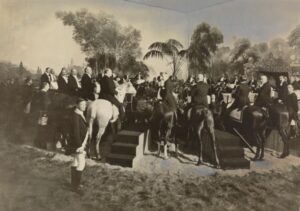
One such dinner was hosted by millionaire C K G Billing and was held at a swanky New York restaurant. Now just imagine having all those horses inside a restaurant. It would take a week to clean up afterward, I’m sure, and all of this came at an enormous cost. Billing’s bill came to $50,000, an amount unimaginable to most people in the world, but for Billing…well, he was just showing off! As for the guests…I’m sure it was considered a once-in-a-lifetime occasion, or at the very least, I’m sure they hoped it would only be a once-in-a-lifetime event. Who in their right mind would want to repeat such a dinner? Certainly not me!! And I venture to say, these guests didn’t either.
 Many people think of the National Guard as a way to avoid going to war. They think that the Guard is designed to be a type of civil service group, but the reality is that they are a military, or actually a militia group. Never has that fact come to light more than now. The National Guard is considered a part of the reserve components of the United States Army and the United States Air Force. The difference between the regular military forces and the National Guard is that the National Guard usually serves in the United States, and not in wars abroad. Still, the president of the United States can “federalize” the National Guard for military action abroad. Reserve forces, including the guard, have made up about 45 percent of the personnel deployed to fight in Iraq and Afghanistan since 2001. While the deployment in Iraq and Afghanistan is currently the case, it is not normal procedure.
Many people think of the National Guard as a way to avoid going to war. They think that the Guard is designed to be a type of civil service group, but the reality is that they are a military, or actually a militia group. Never has that fact come to light more than now. The National Guard is considered a part of the reserve components of the United States Army and the United States Air Force. The difference between the regular military forces and the National Guard is that the National Guard usually serves in the United States, and not in wars abroad. Still, the president of the United States can “federalize” the National Guard for military action abroad. Reserve forces, including the guard, have made up about 45 percent of the personnel deployed to fight in Iraq and Afghanistan since 2001. While the deployment in Iraq and Afghanistan is currently the case, it is not normal procedure.
“The National Guard is a military reserve force composed of military members or units from each state and the territories of Guam, the Virgin Islands, Puerto Rico, and the District of Columbia, for a total of 54 separate organizations. All members of the National Guard of the United States are also members of the organized militia of the United States as defined by 10 U.S.C. § 246. Unlike the other parts of the military, these units are under the dual control of the state governments and the federal government, and can be deployed in disasters like hurricanes, tornados, floods, and even in situations of civil unrest and terrorist attacks.”
The National Guard was strictly a state-run militia before June 3, 1916, at which time, President Woodrow Wilson signed into law the National Defense Act, which expanded the size and scope of the National Guard. Prior to the National Defense Act, the National Guard was used for the needs of each state only. I never really thought about a state-run militia before, but the network of states’ militias that had been developing steadily  since colonial times, was now given the guaranteed status as the nation’s permanent reserve force. In times of the draft, the National Guard didn’t really get deployed. There were always enough soldiers available. It would most likely have to be a long-drawn-out war with many casualties before the National Guard was called out…as in Iraq and Afghanistan.
since colonial times, was now given the guaranteed status as the nation’s permanent reserve force. In times of the draft, the National Guard didn’t really get deployed. There were always enough soldiers available. It would most likely have to be a long-drawn-out war with many casualties before the National Guard was called out…as in Iraq and Afghanistan.
Theodore Roosevelt and other Republicans felt that the United States needed to get into World War I, in the first half of 1916, but with forces from the regular US Army, as well as the National Guard called out to face Mexican rebel leader Pancho Villa during his raids on states in the American Southwest, the need to reinforce the nation’s armed forces and increase US military preparedness became very apparent. The National Defense Act, ratified by Congress in May 1916 and signed by Wilson on June 3, brought the states’ militias more under federal control and gave the president authority, in case of war or national emergency, to mobilize the National Guard for the duration of the emergency. A logical use of the National Guard would have been during the riots seen in our country in 2019. The problem was that each state had to ask for help and some just didn’t.
One provision of the National Defense Act was that the term National Guard was to be used to refer to the combined network of states’ militias that became the primary reserve force for the US Army. The term had first been adopted by New York’s militia in the years before the Civil War in honor of the Marquis de Lafayette, a French hero of the American Revolution who commanded the “Garde Nationale” during the early days of the French Revolution in 1789. I guess they liked the name and felt like it accurately depicted the purpose of this 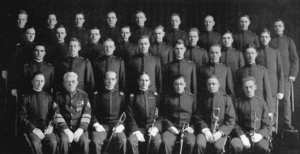 military force. Certain qualifications were also set in the National Defense Act. National Guard officers were allowed to attend Army schools. Also, all National Guard units would now be organized according to the standards of regular Army units. For the first time, National Guardsmen would receive payment from the federal government not only for their annual training…which was increased from 5 to 15 days, but also for their drills, which were also increased, from 24 per year to 48. Finally, the National Defense Act formally established the Reserve Officer Training Corps (ROTC) to train high school and college students for Army service.
military force. Certain qualifications were also set in the National Defense Act. National Guard officers were allowed to attend Army schools. Also, all National Guard units would now be organized according to the standards of regular Army units. For the first time, National Guardsmen would receive payment from the federal government not only for their annual training…which was increased from 5 to 15 days, but also for their drills, which were also increased, from 24 per year to 48. Finally, the National Defense Act formally established the Reserve Officer Training Corps (ROTC) to train high school and college students for Army service.

 My sister, Alena Stevens has been retired now for two years, and while you might this is a time in her life when things slow down and she finds herself with lots of time on her hands, you would be wrong. Alena has a granddaughter in Sheridan, Wyoming named Elliott Stevens, and a little sister coming in June. That makes for lots of trips to Sheridan to see those sweet little granddaughters. Of course, Alena doesn’t mind making those trips one little bit, because as we all know, grandbabies are the greatest blessings ever. Alena has also found herself with two bonus grandchildren, and she couldn’t be happier about that. Brooklyn and Jaxon Killinger are the children of her youngest child, Lacey’s boyfriend, Chris Killinger. Alena has wanted to be a grandmother for a long time, and when that got going, it has really snowballed. Right now, she is just enjoying that “snowball” effect. And waiting for the next “storm” of babies.
My sister, Alena Stevens has been retired now for two years, and while you might this is a time in her life when things slow down and she finds herself with lots of time on her hands, you would be wrong. Alena has a granddaughter in Sheridan, Wyoming named Elliott Stevens, and a little sister coming in June. That makes for lots of trips to Sheridan to see those sweet little granddaughters. Of course, Alena doesn’t mind making those trips one little bit, because as we all know, grandbabies are the greatest blessings ever. Alena has also found herself with two bonus grandchildren, and she couldn’t be happier about that. Brooklyn and Jaxon Killinger are the children of her youngest child, Lacey’s boyfriend, Chris Killinger. Alena has wanted to be a grandmother for a long time, and when that got going, it has really snowballed. Right now, she is just enjoying that “snowball” effect. And waiting for the next “storm” of babies.


While Alena doesn’t mind driving to Sheridan alone, the fact that her husband, Mike is retiring July 1st after 39 years in the oilfield business, means that now they can both make the trips to see the granddaughters. They also plan to do lots of camping, traveling, and golfing too. If I know my sister, there will also be some redecorating, remodeling, or re-envisioning changes to their home too, so I’m sure they will be busy with that. Alena should have been an interior decorator, so there are always ideas rolling around in her head. Don’t get me wrong, Alena was an amazing special education aid, but she is also a gifted decorator, and her home shows that off nicely. Alena has an eye for color, and a natural flair for the glamorous.

 Alena has also been working on getting slim and healthy this past year…and she looks amazing. She loves sharing the recipes she uses, and plenty of low carb healthy alternatives to everyday recipes too. She has been quite focused on soups lately, and the ideas she has are amazing. A lot of times, the spouse of the “dieter” has no desire to eat any of the food that the “dieter” is eating, but Alena has been able to tempt Mike to eat lots of the recipes she is using, so it’s a healthy lifestyle for both of them these days. As anyone who knows Alena can see, she looks absolutely amazing these days, and we are all very proud of her transformation. Today is Alena’s birthday. Happy birthday Alena!! Have a great day and keep up the good work!! We love you!!
Alena has also been working on getting slim and healthy this past year…and she looks amazing. She loves sharing the recipes she uses, and plenty of low carb healthy alternatives to everyday recipes too. She has been quite focused on soups lately, and the ideas she has are amazing. A lot of times, the spouse of the “dieter” has no desire to eat any of the food that the “dieter” is eating, but Alena has been able to tempt Mike to eat lots of the recipes she is using, so it’s a healthy lifestyle for both of them these days. As anyone who knows Alena can see, she looks absolutely amazing these days, and we are all very proud of her transformation. Today is Alena’s birthday. Happy birthday Alena!! Have a great day and keep up the good work!! We love you!!

 My youngest daughter, Amy Royce has always loved plants and dreamed of having a beautiful garden. Unfortunately, the short growing season in Wyoming didn’t make that easy for her. Amy has always had a vision of what her brand of paradise would be like, and I’m certain that when she gets to Heaven, she will have a place that is a whole lot like the Butchart Gardens. As far as Amy is concerned, you can never have too many plants and flowers. Just going to the store for groceries can be a “dangerous” outing for Amy…financially that is. There are flowers everywhere this time of year. To make matters worse…Amy lives just one street away from a nursery with lots of exotic plants. Oh boy!! Fortunately, her husband, Travis is ok with all the flowers and plants…provided she does the watering and weeding…hahaha!! It’s a good thing that Amy likes playing in the dirt.
My youngest daughter, Amy Royce has always loved plants and dreamed of having a beautiful garden. Unfortunately, the short growing season in Wyoming didn’t make that easy for her. Amy has always had a vision of what her brand of paradise would be like, and I’m certain that when she gets to Heaven, she will have a place that is a whole lot like the Butchart Gardens. As far as Amy is concerned, you can never have too many plants and flowers. Just going to the store for groceries can be a “dangerous” outing for Amy…financially that is. There are flowers everywhere this time of year. To make matters worse…Amy lives just one street away from a nursery with lots of exotic plants. Oh boy!! Fortunately, her husband, Travis is ok with all the flowers and plants…provided she does the watering and weeding…hahaha!! It’s a good thing that Amy likes playing in the dirt.
Amy is a Wyoming-born-and-raised…coastal girl!! Don’t ask me how that happened, but it did. All the years she was growing up, something was forming in the back of her mind…a calling to the coast. I have never seen her happier. There are side of her that are coming out that I never knew existed…the artsy side, for example. In addition to her “green thumb,” I have found that Amy has a talent for painting, and I’m not talking about rooms 

 or houses. I find her paintings to be quite beautiful. Maybe she has been inspired by her chosen home in the rainforest of western Washington state. Or maybe it was a talent she has always had, but never did anything with until she found a place that inspired her.
or houses. I find her paintings to be quite beautiful. Maybe she has been inspired by her chosen home in the rainforest of western Washington state. Or maybe it was a talent she has always had, but never did anything with until she found a place that inspired her.
Amy has always been a peace-loving girl. She likes things that are quiet and have an air of peace…like the country atmosphere of her current home. While she likes peace and quiet, she also doesn’t mind the loud music of a band…especially the one her husband, Travis Royce and son, Caalab Royce play in, and her daughter, Shai Royce sometimes sings with. Often the whole family has a family band night, and they have a lot of fun entertaining each other with their music. I enjoy that too. They all really have talent, and it is fun to listen to.
Amy is a seafood lover…another reason that being a coastal girl is nice. As anyone who has tasted 
 fresh seafood, locally caught will tell you, the seafood that is trucked in frozen…just can’t compare to the real deal. Amy even loves sushi, which I still have a hard time wrapping my mind around, as well as escargot, which I seriously can’t wrap my head around. I love seafood with the best of them, but I have to draw the line somewhere…and escargot is definitely the line drawn!! I guess all that is part of what makes the West Coast area of Washington home for my Wyoming-born-and-raised coastal girl. Today is Amy’s birthday. Happy birthday Amy!! Have a great day!! We love you!!
fresh seafood, locally caught will tell you, the seafood that is trucked in frozen…just can’t compare to the real deal. Amy even loves sushi, which I still have a hard time wrapping my mind around, as well as escargot, which I seriously can’t wrap my head around. I love seafood with the best of them, but I have to draw the line somewhere…and escargot is definitely the line drawn!! I guess all that is part of what makes the West Coast area of Washington home for my Wyoming-born-and-raised coastal girl. Today is Amy’s birthday. Happy birthday Amy!! Have a great day!! We love you!!

